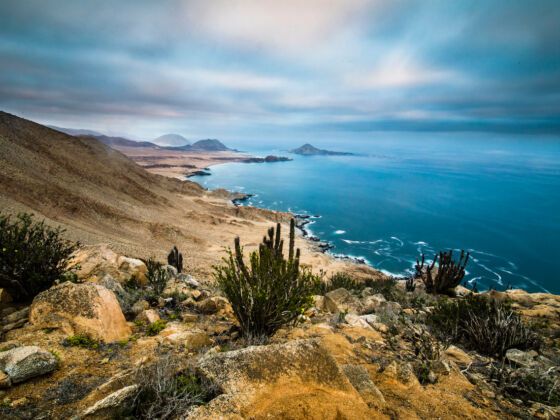Most visitors to northern Chile make a beeline to the small inland town of San Pedro de Atacama and never look back. Yet, the best combination of the region’s two most rewarding natural resources — the desert and the coast — is found a few hundred miles to the southwest.

Natural diversity: from desert, to beaches, to penguins
Pan de Azucar National Park occupies over 43,000 hectares, straddling the border of Chile’s Regions II and III. There’s a thin strip of coastal paradise, flanked by miles and miles of desert stretching away from the shore.
Beach camping is what’s on tap. Wake up to an ocean sunrise, join the seagulls and sandpipers for a quick dip in the sea, and then relax on the sand.
Once you’ve had your fill of beach soccer, surfing, and sunbathing, take a hike to the top of the Mirador for an excellent view of the stark Atacama landscape. Ask the park rangers for more information on the Mirador walk, along with other hiking opportunities.
And don’t forget the penguins! Boats depart from Caleta for tours around Isla Pan de Azucar. There you’ll see sealions laze and bark and Humboldt penguins chatter amongst themselves on the shore.
How to get there
The park lies 800 km north of Santiago and just 30 km from Chañaral. Renting a car, which can be done in Antofagasta or Copiapó, is the most convenient way to reach Pan de Azucar. Hitchhiking is also possible, helped by the fact that Chile is probably South America’s safest country.
A third option is to take a bus to Chañaral, conveniently located on the Pan-American Highway, and then hop a minibus or collectivo to the park.
Where to stay
The four campgrounds (Caleta Pan de Azucar, Piqueros, Soldado, and Piqueros Norte) sit on long strips of white-sand beach, ten minutes from the park entrance.
Soldado and Piqueros Norte are group areas — Soldado mainly sees families, while Piqueros Norte is where young singles flock.
These two campgrounds are the best; the sites are located farther apart from each other for more privacy, and they offer the best views of the ocean. They come with a canopy, campfire ring, and table and chairs. Nearby are bathrooms and cold-water showers, plus sinks for washing dishes.
Also available are a few “fully equipped” beach cabanas, each sleeping six.
Caleta and Piqueros are less expensive but sites are cramped — your view may very well consist of the back of another tent.
Sign up for a campsite at the administration station, which is open from 8:30-12:30am and 2-6pm.
Costs
Beach cabanas: $20,000-$40,000 CLP per night, depending on the season
Campsite at Piqueros Norte or Soldado: $3500 CLP per person, per night
Campsite at Caleta or Piqueros: $2000 CLP per person, per night
Park entrance fee: $3500 CLP per person ($1500 CLP for children)
Boatride to Isla Pan de Azucar: $5000 CLP per person
Special tip: The budget-conscious can try talking to the rangers about a “servicio.” Depending on their mood, you might be able to convince them to let you pick up litter on the beach or empty the garbage bins in the bathrooms in exchange for a night’s stay.
Additional tips
* Though Caleta has a small store, its prices are exorbitant and its selection meager. Buy food and supplies before arriving. There are also vendors who come through in the afternoon with empanadas and sweets, but you shouldn’t rely on them either.
* Pack a flashlight, matches, a knife, plastic bags for trash, sunblock, and sunglasses. These are must-haves for camping in Pan de Azucar.
* A visit in spring (October, November, and December) will give you a look at the blossoming of exotic desert plants and families of guanacos (related to llamas).
* Despite the ocean’s tempering influence, this is still the desert — it gets cold at night, so bring a good jacket and a hat to stay warm.
*If you love the night sky, you’ll love Pan de Azucar. Pack your star map for some serious star gazing.
Community Connection
Matador is the place to read up on Chile! Relevant titles include:
Chile’s Best Coast Towns (which, incidentally, happens to feature Pan de Azucar)
10 Reasons to Base Your Study Abroad Experience in Chile
7 Reasons to Learn Spanish in Chile
What People Are Listening to in Chile
Trekking Torres Del Paines, Patagonia, Chile